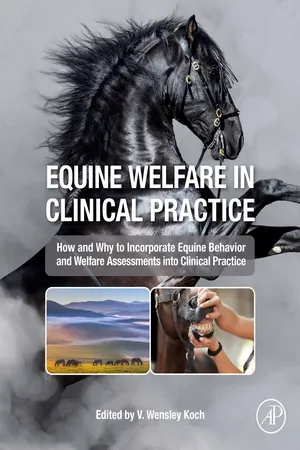
This is a test
- 370 pages
- English
- ePUB (mobile friendly)
- Only available on web
eBook - ePub
Equine Welfare in Clinical Practice
Book details
Table of contents
Citations
Frequently asked questions
At the moment all of our mobile-responsive ePub books are available to download via the app. Most of our PDFs are also available to download and we're working on making the final remaining ones downloadable now. Learn more here.
Both plans give you full access to the library and all of Perlego’s features. The only differences are the price and subscription period: With the annual plan you’ll save around 30% compared to 12 months on the monthly plan.
We are an online textbook subscription service, where you can get access to an entire online library for less than the price of a single book per month. With over 1 million books across 1000+ topics, we’ve got you covered! Learn more here.
Look out for the read-aloud symbol on your next book to see if you can listen to it. The read-aloud tool reads text aloud for you, highlighting the text as it is being read. You can pause it, speed it up and slow it down. Learn more here.
Yes, you can access Equine Welfare in Clinical Practice by Virginia Wensley Koch in PDF and/or ePUB format, as well as other popular books in Biological Sciences & Zoology. We have over one million books available in our catalogue for you to explore.
Information
Table of contents
- Cover image
- Title page
- Table of Contents
- Copyright
- Contributors
- About the contributors
- Foreword
- Acknowledgments
- Introduction
- Chapter 1 Assessing equine welfare: Operationalizing the Five Domains Model for veterinary practitioners
- Chapter 2 Principles of learning for equine clinicians
- Chapter 3 Minimizing fear associated with veterinary procedures
- Chapter 4 Raising well-trained and sustainable foals
- Chapter 5 Equine training and behavior modification: The good, the bad and the ugly
- Chapter 6 Diet and behavior, including the effects of the gut microbiome
- Chapter 7 How horses perceive their world—What can practitioners share with their clients to enhance safety and welfare?
- Chapter 8 Between the horses ears: Equine cognition, welfare implications, and why it matters for equine practitioners
- Chapter 9 Environmental enrichment
- Chapter 10 Distinguishing physical vs psychological causes of behavior and performance problems
- Chapter 11 Prevention and treatment of horse behavior problems and “vices”, including stereotypic behavior
- Chapter 12 The Equine Behavior Assessment and Research Questionnaire (E-BARQ): How citizen science can enhance veterinary practice
- Chapter 13 Veterinary ethics and equine welfare: Principalism, a Five Cs approach, and ethical decision-making in support of the duties to care and guide
- Chapter 14 Finding help
- Index